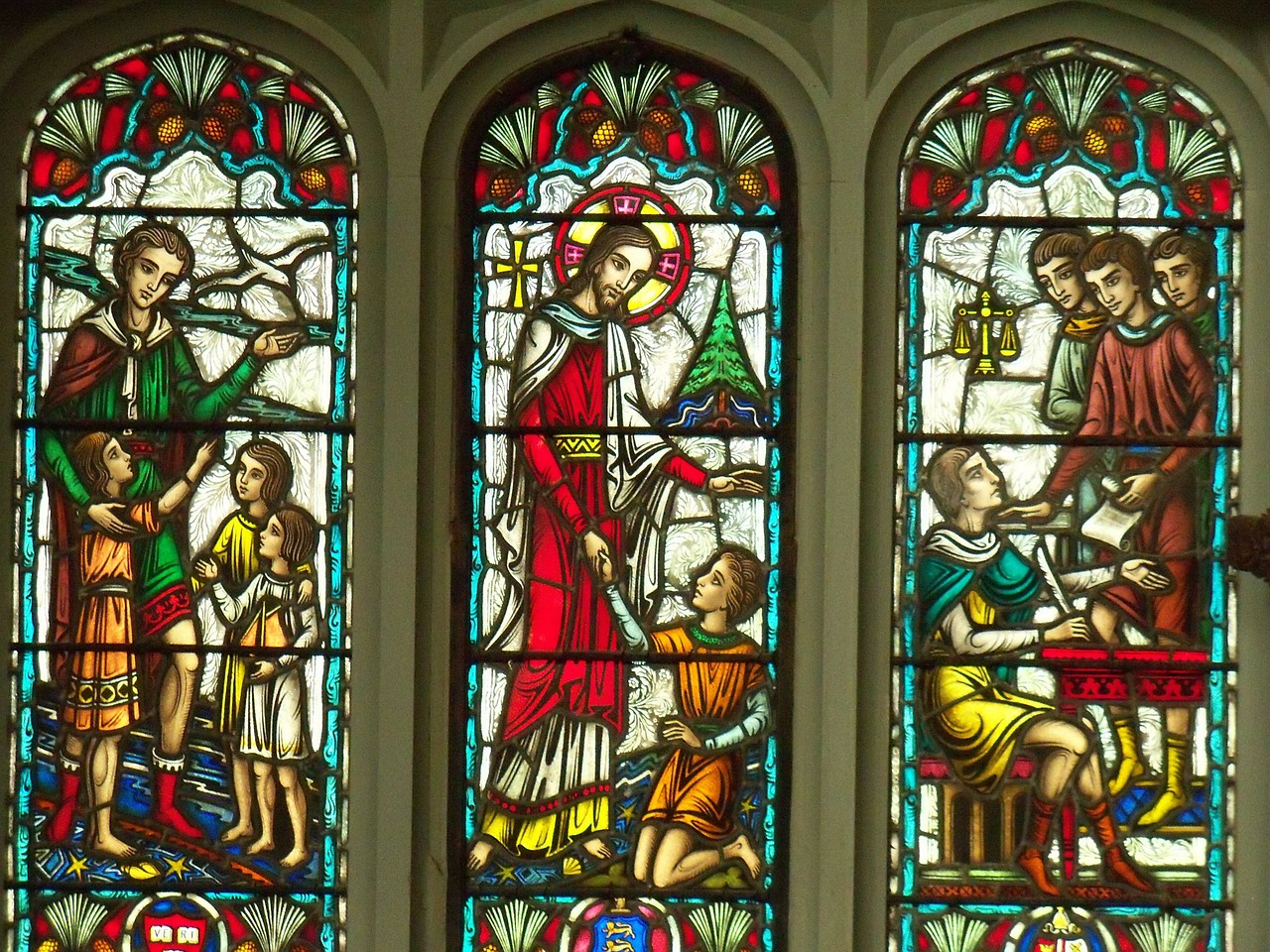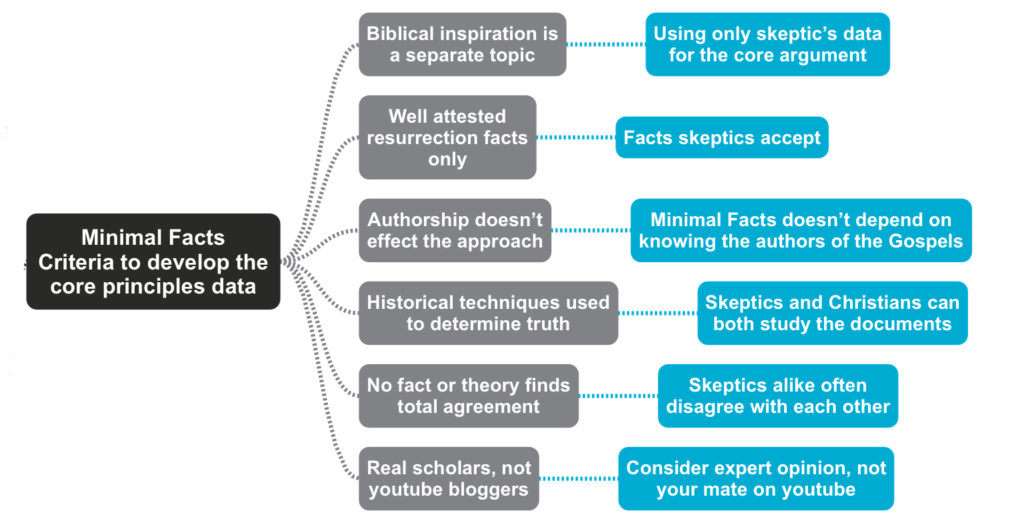2.4 Minimal Facts method

A simple method for sharing the resurrection
1. Two argument types
2. Two crucial criteria
Two argument types
There are two kinds of arguments for the Resurrection. Some philosophers, like William Lane Craig and Gary Habermas, argue that the Resurrection of Jesus is the Best Explanation of certain facts about history. It’s the same sort of reasoning used in medicine. For instance, suppose that you’ve got a sore throat, cough, and runny nose and decide to go to the doctor. In this case, the doctor infers that a “cold” best explains the symptoms. So they prescribe you some antibiotics and rest and sends you on your way. This is first type of argument for the Resurrection. It’s called an inference to the Best Explanation. It seeks to establish the Resurrection as the best explanation of certain historical facts.
The second type of argument for the Resurrection is a bit more technical. This one involves what is called Bayesian probability. This one says we start with what we know about how likely the Resurrection of Jesus is before looking at the evidence, and then update this probability after we take the evidence into account. So there are two steps to this version. First we need to see how likely the Resurrection is before looking at the evidence. Maybe we’ll calculate this based on how likely it is that God exists and whether He would have reason to raise Jesus from the dead. Once we have that figure in mind, we then look at the evidence and update our probability. If the evidence strongly favours the Resurrection, then our final analysis will result in a high likelihood that the Resurrection actually took place. Richard Swinburne and Timothy McGrew use this kind of argument in their work. We cover this methodology mainly when responding to opposing theories concerning probability.
The Minimal Facts approach
The minimal facts approach seeks evidence with a high degree of certainty. It considers only those data that are so strongly attested historically that they are granted by nearly every scholar who studies the subject, even sceptical scholars!
Most facts will meet 2 key criteria:
- They are well evidenced
- Nearly every scholar accepts them
This way we have a strong argument. That is both supportable and compelling.
When we talk about resurrection, reliability of the bible does not come into play, that is a separate topic, you would take another approach for that topic. Believer and sceptic alike accept the facts on the resurrection because they are well attested for and historians look for these kernels of historical truth within these sources using techniques to determine authenticity. So we don’t need to spend time in the topic of inspired text. We are told to believe in the resurrection for eternal life, not inerrancy, we need to keep to the core topic. But the aim is not to dismiss the Old and New Testament documents, it is to treat the document as you would any other book in antiquity. The person you’re talking to may not be a Christian so play behind enemy lines, don’t come presupposing inspiration.
When it comes to historians looking for Kernels of truth we use the example of Tacitus. Tacitus is considered the greatest roman historian. Scholars recognise that Tacitus sometimes writes with a heavy bias, but they are still able to benefit greatly from his work. They can weed through the bias and use historical study techniques to yield much that can be known with a great deal of historical certainty. We do this with all known history.
The New Testament is a compilation of writings from various authors that the early church considered authoritative. Scholars debate dating and authorship of some of these but these don’t affect the minimal facts approach, we only consider content that is strongly evidenced and considered historical virtually by all who study the subject (E.G. Authorship of the gospels and Acts is disputed, but the teachings can historically be traced back to Jesus). We will use the books scholars (Even the sceptical ones) do agree on and accept as having some truth, for them to accept such truths requires a lot of historical data. If most sceptics are willing to reject a natural theory, even though that theory supports their opposition of Jesus’ resurrection, it infer that theory must be one that is not supported well by the evidence.
No fact or theory finds total agreement, sceptics are known for disagreeing with each other. There are always extreme views with far-fetched theories, but they are a very small minority and with little to no data to back their claims. So this approach bases what the majority of scholars agree on, not what 18 year old Jeff on his YouTube account thinks. Focus on evidence for the resurrection in the minimal facts approach rather than the inadequacies of opposing theories.
If a sceptic takes the position against the majority of what scholars believe, we can argue for the Explanatory power of the facts we are using. In this case, the believer now has a chance to present much more data in support for the argument of Jesus’ resurrection, to which, the sceptic will have to respond.

Six statements
So six conclusions I’d like to state from our two minimal facts criteria when discussing with sceptics and believers alike:
- Don’t get drawn into inspiration discussions, that’s another conversation
- Use only well attested facts (there are way more than 5, but this keeps things easy).
- Authors of the gospels doesn’t change the fact these are historical documents credited by many as pre70AD.
- We have historical methods to determine truth likelihood considering the circumstances and events surrounding.
- We know no fact or theory finds total agreement, sceptics often debunk each other while attacking the christian resurrection (Strauss on Swoon theory for example). For every opposing theory presented by a critic, there’s a sceptical critic attacking that theory, and if they’re not, we have enough data to state why the opposing theory is miraculous at best, ironically.
- Considers scholars data, not youtube Bloggers ‘authoritative tones’, ‘debunk titles’ and ‘religious giggles’.
The Facts
As I’ve said there are more than five facts for the resurrection of Jesus, but these are the best attested for and ones people would probably like to know about (there are about 12 strong facts sceptics grant). The First four have an overwhelming amount of evidence and they are unquestioned by almost everyone, this includes sceptical, non-christian scholars. The fifth fact has a majority acceptance though not as overwhelming as the other four. So the argument is nicknamed the 4+1 approach. So four of them have 90%+ acceptance, the Empty Tomb is over 75% but not quite 90%.

Minimal Facts evidences
The Resurrection is the one miracle from history that has more evidence than any other miracle claim. Anthony Flew, famous atheist philosopher who became a deist at the end of his life admitted “The evidence for the resurrection is better than for claimed miracles in any other religion, It’s an outstandingly different in quality and quantity…”
If all the evidence points in favour of resurrection and someone doesn’t think it is enough because they’ve arbitrarily set the bar so high that it cannot be reached, this would not refute the overall case, offer a better explanation for the evidence or show the evidence doesn’t infer that the resurrection most likely happened. The goal is not to prove it true like a repeatable lab experiment, It happened in the past and so it cannot be repeated. This can only be investigated with historical facts or how someone may conduct a forensic investigation. Aviezer Tucker, philosopher of history and historiography states “Historiography does not reconstruct events; it cannot bring Caesar back to life or reenact the battle of Actium. Historiography does not attempt to provide a hypothetical description and analysis of some past events as the best explanation of the present evidence.” You would evaluate the evidence and infer to the theory that can best explain the data.
When investigating the claim, Christians and sceptics alike must apply methodical neutrality. The one making the claim bears the burden of the evidence to begin with. If I say Jesus rose, then I need to say why that best fits with the data. The sceptic in response cannot just say they are wrong, they would have to counter the argument with a better explanation of the data to what they think happened and show why the resurrection explanation is insufficient in explaining the data.
D.H. Fischer, Professor in history writes in Historical Fallacies: Toward a Logic of Historical Thought, that the burden is always on the one making the claim, but also the one making the rebuttal or the opposing claim (An inference from his work). You can remain agnostic on the issue but that personal conviction doesn’t make an objective argument.
One final point is that prior to making a case for the resurrection, if there are good arguments for God’s existence, good reasons to believe the New Testament is reliable and logically demonstrate miracles are possible (which all have strong arguments to back themselves up with), then you have a lot more going into this case (I’ve given some arguments in the appendix than can be researched in more depth) Ok let’s get into these five factors.
Sources for ‘Two argument types’
Sources for ‘Minimal facts approach’
- Minimal Facts approach: Gary Habermas has developed this approach in some detail; see Gary R. Habermas, “Evidential Apologetics”, Five views on Apologetics, Steven B. Cowan, ed. (Grand Rapids: Zondervan, 2000), 99-100, 186-90
- Gary Habermas & Mike Licona: The Case for the Resurrection of Jesus
- Biblical inspiration doesn’t determine salvation: Romans 10:9; 1 Corinthians 15:1-5
- Tacitus: Moses Haidas, “Introduction,” The Complete Works of Tacitus, Moses Hadas, ed.; Alfred John Church and William Jackson Brodribb, xvi-xviii
- Gary Habermas & Mike Licona: The Case for the Resurrection of Jesus
12 historical facts:
- Gary Habermas, The Historical Jesus p158-167
- Gary Habermas and J.P. Moreland, Beyond Death, p115
- Antony Flew, considered one of the most influential philosophical atheists of the latter part of the 20th century granted all 12 of these facts in a live tv debate with Gary Habermas April 2000 (I believe the debate is on youtube on John Ankerberg’s channel
Sources for ‘Minimal facts evidences’
- Did the Resurrection Happen p85 —. Anthony Flew
- Historiographical Counterfactuals and Historical Contingency, p258 — Aviezer Tucker
- https://youtu.be/-ErnJF_nwBk



0 Comments